Corporate Governance
History of the Board of Directors
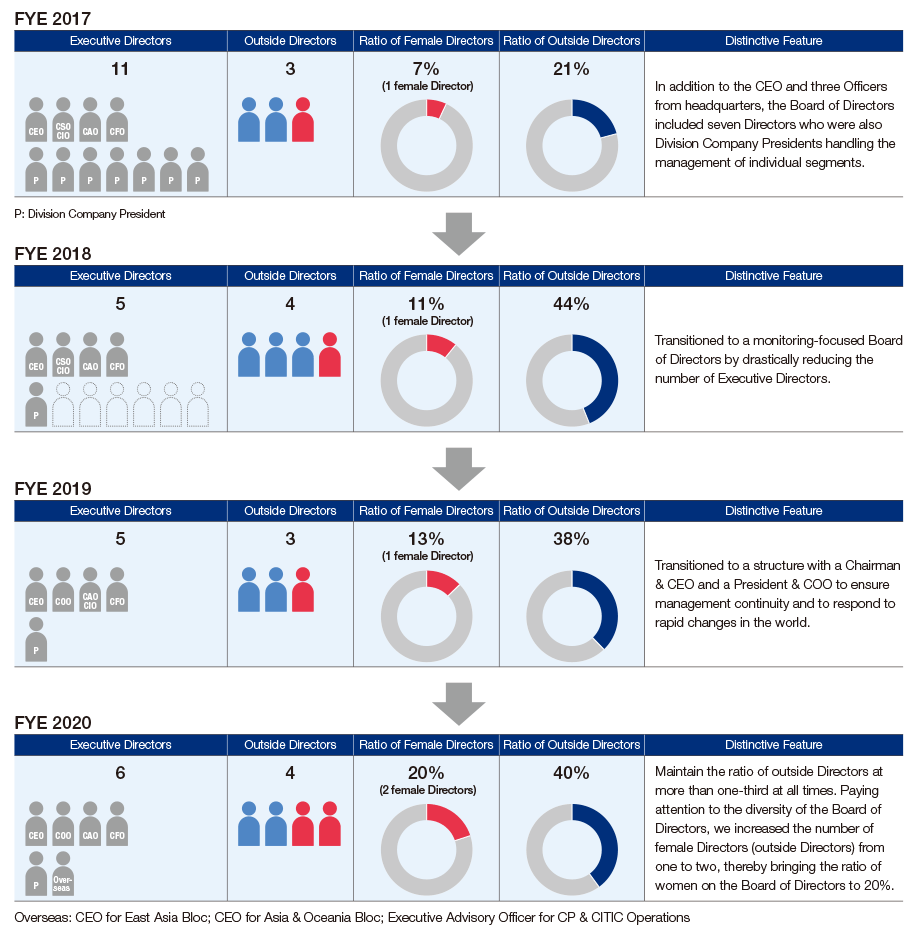
Messages from Outside Directors
Aiming for Further Enhancement of the Effectiveness of the Board of Directors
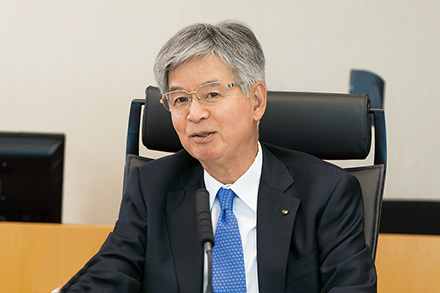
Outside Director
Mr. Mochizuki was appointed as an Audit & Supervisory Board Member of ITOCHU in June 2014 and a Director in June 2017,
following a position as the Vice Minister of Economy, Trade and Industry. In FYE 2019, he served as the Chairman of the Nomination Committee, and lead deliberations on the appointment and dismissal of key management members and succession plans. He provides many beneficial and broad-minded suggestions on topics including internal control, compliance, and next-generation of business.
I have a strong sense that the effectiveness of the Board of Directors has improved demonstrably in the two years since I was appointed as an outside Director. At meetings of the Board of Directors, we outside Directors are provided with sufficient information on proposals, while Inside Directors, including the Chairman of the Board of Directors, display a willingness to take into account outside perspectives when making management decisions. I believe that such a stance leads to more open and lively debate and is therefore very effective. Depending on the proposal, it is necessary for outside Directors to exercise their supervisory functions on subjects such as internal control and compliance. To enable outside Directors to do that, we must fully understand internal conditions such as the true state of the Company’s business and the circumstances surrounding proposals, otherwise deliberations will not be effective. At ITOCHU, outside Directors are able to deepen their understanding of the Company’s business through a variety of opportunities, including site visits to Group companies in Japan and overseas, and business explanations at Division Companies.
Moreover, it was decided in FYE 2019 that the Nomination Committee where I serve as Chairman would periodically deliberate on succession plans. I intend to continue to contribute to the sustainable development of the Company through conducting more effective and substantive discussions on this important issue for the Company.
Realizing “a New Vision of What a Trading Company Can Achieve”
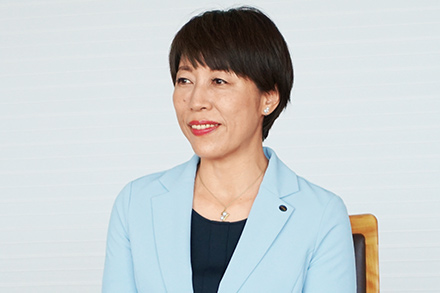
Outside Director
Ms. Nakamori possesses a high level of expertise on finance and accounting as a certified public accountant and a wealth of experience as a corporate manager. She was appointed as a Director of ITOCHU in June 2019 and a member of the Governance and Remuneration Committee.
In order to establish sustainable growth foundations, ITOCHU is pursuing evolution to next-generation growth models by leveraging new technologies through proactive growth investments, asset replacements, and other strategies. I am looking forward to being able to witness at first hand, and play a part in realizing “a new vision of what a trading company can achieve,” the major turning point in ITOCHU’s long history spanning more than 160 years.
In addition to acquiring expertise as a certified public accountant engaged in the auditing of numerous companies, I have also been involved in management as an outside Director or an outside auditor at several venture companies. I hope to contribute to ITOCHU’s “reinvention of business” going forward based on my experiences at a wide range of companies.
I am the second female Director to be appointed as a member of the current Board of Directors. I believe that one of the effects of the proactive promotion of diversity at the Board of Directors is that opinions based on diverse viewpoints can be exchanged at meetings of the Board of Directors. By participating in discussions with a focus on diverse values, including as a woman, I hope to improve the content of the meetings of the Board of Directors and contribute to the further enhancement of the Company’s corporate governance.
Principal Areas of Experience of Outside Directors and Outside Audit & Supervisory Board Members
ITOCHU transitioned to a monitoring-focused Board of Directors in FYE 2018 with the goal of encouraging separation between management execution and supervision. As a Board of Directors that is able to conduct appropriate supervision of management, we appoint Officers who are in charge of headquarters administrative divisions and several outside Directors in order to maintain the ratio of outside Directors at more than one-third.
We appoint as Internal Directors persons who possess extensive work experience and expertise in all aspects of the management of general trading companies. As for outside Directors, we further heighten the functions of the Board of Directors by appointing diverse individuals or those with more specialized perspectives. As for outside Audit & Supervisory Board Members, we appoint persons possessing knowledge of finance, accounting, and legal affairs, thereby enabling monitoring and supervision of the Board of Directors from a neutral and objective perspective.
The roles and principal areas of experience of outside Directors and outside Audit & Supervisory Board Members we appoint are as follows.
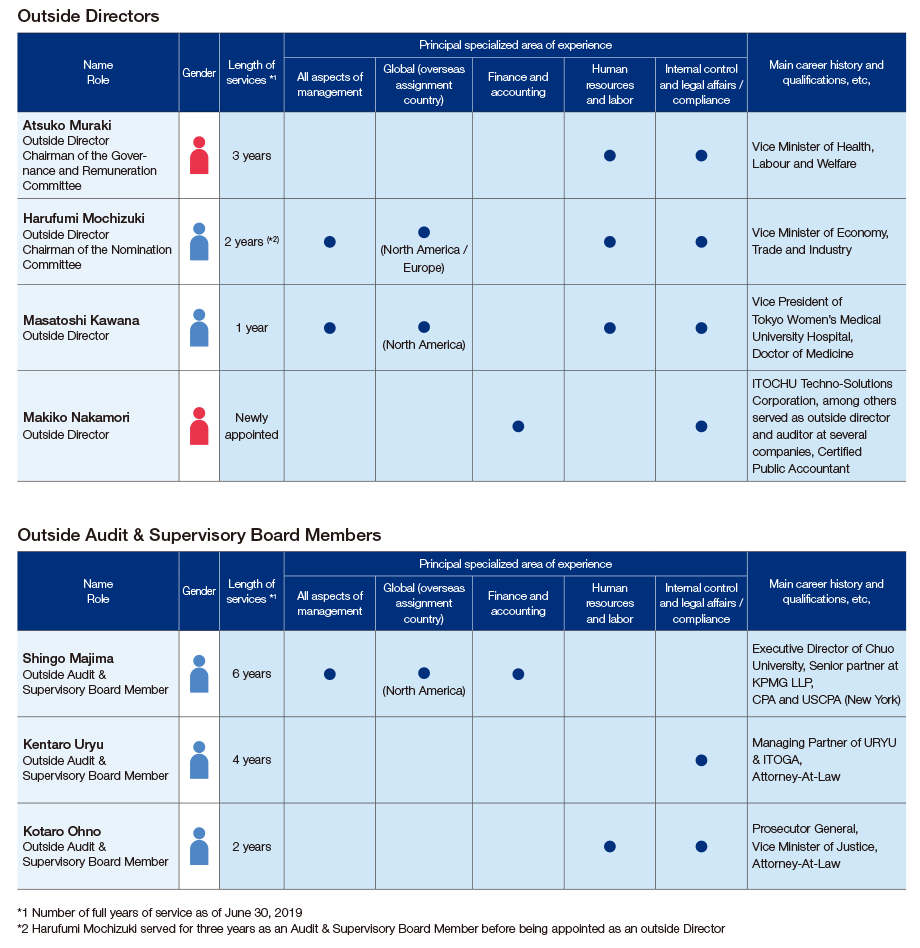
Overview of Board of Directors’ Effectiveness Evaluation
ITOCHU implements effectiveness evaluations of the Board of Directors with the goal of maintaining and enhancing the effectiveness of the Board of Directors.
Procedure for the Evaluation in FYE 2019
| Respondents | All of eight (8) Members of the Board and five (5) Audit & Supervisory Board Members in FYE 2019 |
|---|---|
| Method of Implementation | Conduct anonymous questionnaires and individual interviews with each of respondents using external consultants. |
| Questions | Matters relating to the following five major items
|
| Evaluation Process |
|
Overview of the Evaluation Results for FYE 2019
In terms of the structure of the Board of Directors and its advisory committees as well as the roles and duties, operation status, information provision, and training, the Board of Directors of ITOCHU confirmed that the effectiveness of the Board of Directors was secured.
The evaluation by the external consultants concluded that, (1) the scores for most questions in the questionnaires have improved, (2) the Chairman of the Board of Directors as well as the secretariat have cooperated with outside Directors to improve the governance and realize more efficient and higher density operation of the Board of Directors, and (3) the objectivity, independence, and transparency of the advisory committees to the Board of Directors have been improved due to the efforts of both Inside Directors and outside Directors.
Progress on Issues Highlighted in Effectiveness Evaluation and Issues Going Forward
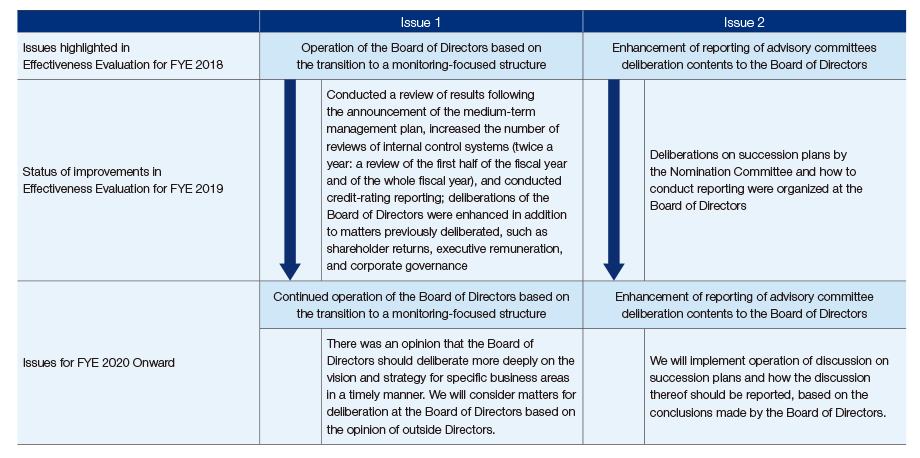
Overview of the Corporate Governance System
Steps Taken to Strengthen Corporate Governance
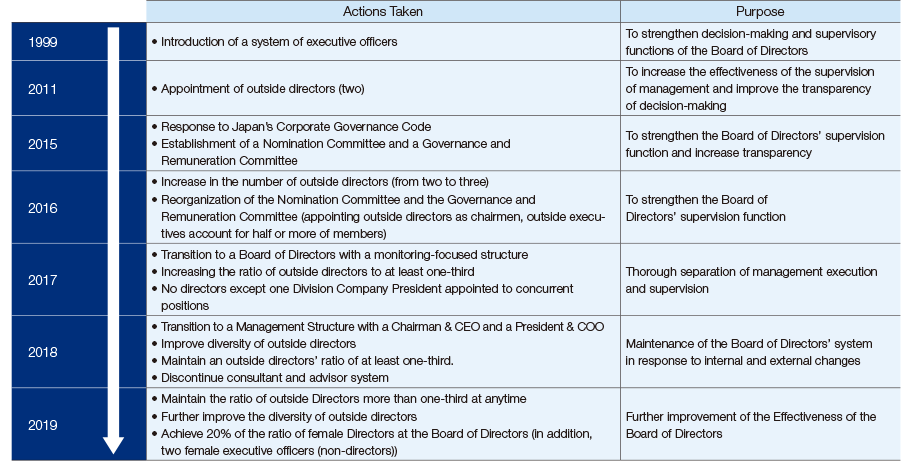
Corporate Governance System
| Type of system | Company with the Board of Directors and Audit & Supervisory Board Members (Audit & Supervisory Board) |
|---|---|
| Number of Directors (Of which, number of outside Directors) | 10 (4) |
| Number of Audit & Supervisory Board Members (Of which, number of outside Audit & Supervisory Board Members) | 5 (3) |
| Term of office for Directors | 1 year (the same for outside Directors) |
| Adoption of an Executive Officer System | Yes |
| Organization to support COO decision-making | HMC*1 deliberates on Companywide management policy and important issues |
| Advisory committees to the Board of Directors | Governance and Remuneration Committee, Nomination Committee |
Overview of ITOCHU’s Corporate Governance and Internal Control System
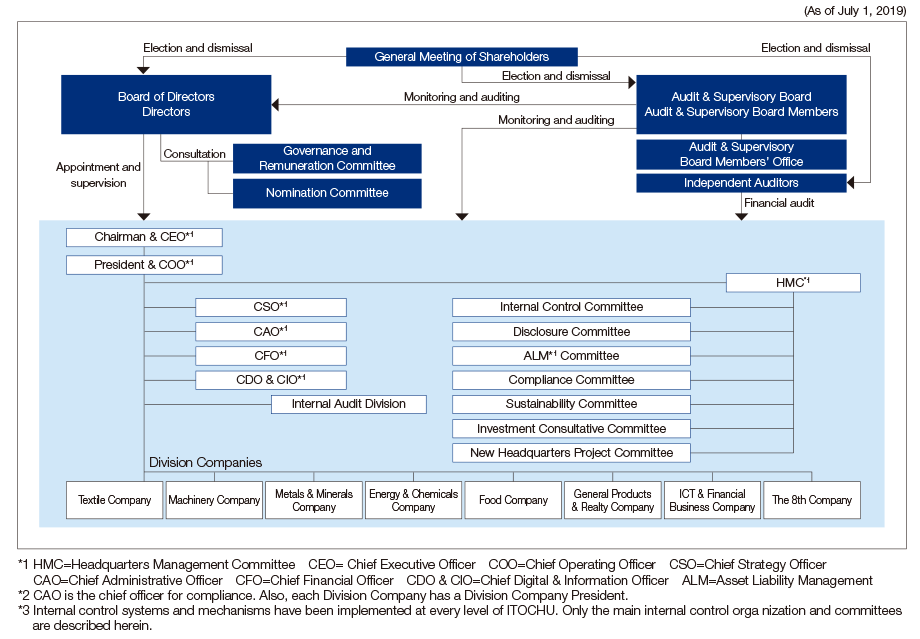
Advisory Committees to the Board of Directors
| Committee Name | Role |
|---|---|
Governance and Remuneration Committee |
Deliberates and advices on proposals related to remuneration system for Directors and Executive Officers and other matters of corporate governance |
Nomination Committee |
Deliberates and advices on proposals related to nomination and dismissal of Executive Officers, nomination of candidates for Directors and Audit & Supervisory Board Members, and appointment and dismissal of responsible Directors and Executive Officers |
Composition of the Governance and Remuneration Committee and the Nomination Committee
| Name | Title | Governance and Remuneration Committee | Nomination Committee |
|---|---|---|---|
Masahiro Okafuji |
Chairman & CEO |
○ |
○ |
Yoshihisa Suzuki |
President & COO |
○ |
○ |
Fumihiko Kobayashi |
Director |
|
○ |
Atsuko Muraki |
Outside Director |
◎(Chair) |
○ |
Harufumi Mochizuki |
Outside Director |
|
◎(Chair) |
Masatoshi Kawana |
Outside Director |
○ |
|
Makiko Nakamori |
Outside Director |
○ |
|
Kiyoshi Yamaguchi |
Audit & Supervisory Board Member |
|
○ |
Shuzaburo Tsuchihashi |
Audit & Supervisory Board Member |
○ |
|
Shingo Majima |
Outside Audit & Supervisory Board Member |
|
○ |
Kentaro Uryu |
Outside Audit & Supervisory Board Member |
|
○ |
Kotaro Ohno |
Outside Audit & Supervisory Board Member |
○ |
|
(7 members) |
(8 members) |
Principal Internal Committees
| Committee Name | Committee Chairman | Purpose |
|---|---|---|
Internal Control Committee |
CAO |
Deliberates on issues related to the development of internal control systems |
Disclosure Committee |
CFO |
Deliberates on issues related to business disclosure and the development and operation of internal control systems in the area of financial reporting |
ALM Committee |
CFO |
Deliberates on issues related to risk management systems and balance sheet management |
Compliance Committee |
CAO |
Deliberates on issues related to compliance |
Sustainability Committee |
CAO |
Deliberates on issues related to sustainability and ESGs |
Investment Consultative Committee |
CFO |
Deliberates on issues related to investment and financing |
New Headquarters Project Committee |
CAO |
Deliberates on issues related to the new Tokyo headquarters project |
FYE 2019 in Review
Results of key initiatives based on our corporate governance system in FYE 2019 were as follows.
| Meetings of the Board of Directors | 17 |
|---|---|
| Outside Directors’ attendance at meetings of the Board of Directors | 100% |
| Outside Audit & Supervisory Board Members’ attendance at meetings of the Board of Directors | 99% |
| Meetings of the Audit & Supervisory Board | 13 |
| Outside Audit & Supervisory Board Members’ attendance at meetings of the Audit & Supervisory Board | 100% |
| (1) Medium-term management plan (including post-announcement review of the Plan) |
|---|
| (2) Shareholder returns |
| (3) Conversion of FamilyMart UNY Holdings Co., Ltd., into a consolidated subsidiary |
| (4) Response to the cease and desist order issued to the Company in FYE 2019 |
| (5) Corporate officer remuneration |
| (6) Responding to revision of the Corporate Governance Code |
Corporate Officer Remuneration
A Highly Transparent Remuneration Plan Linked to Corporate Values
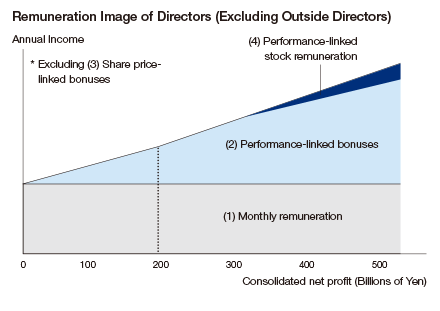
Overview of the Remuneration Plan for Directors
ITOCHU’s remuneration plan for Directors has been designed to provide incentives toward improving operating performance. The ratio of performance-linked bonuses to total remuneration is high, and the plan is its high level of transparency since we have been previously disclosed details including calculation formulas. In order to heighten awareness toward making contributions to improving our performance over the medium and long term and increasing corporate value, we have included stock remuneration as part of remuneration plan.
The FYE 2020 remuneration plan for Directors (excluding outside Directors) comprises (1) monthly remuneration, (2) performance-linked bonuses, (3) share price-linked bonuses, and (4) performance-linked stock remuneration (trust type). Of these, (3) share price-linked bonuses is a revision of the market capitalization-linked bonuses, which were introduced in FYE 2019, and the share price-linked bonuses are not designed on the single-year base used when the market capitalization-linked bonuses were introduced. Instead, the bonus amount is calculated based on the evaluation of the relative growth rate of ITOCHU’s share price during the period of each medium-term management plan versus the growth rate of the Tokyo Stock Price Index (TOPIX). Moreover, we position (2) performance-linked bonuses as remuneration linked to short-term (single-year) performance, while (3) share price-linked bonuses and (4) performance-linked stock remuneration are designed to strengthen awareness toward increasing corporate value over the medium to long term.
Decision-Making Process for Remuneration Plan for Directors
ITOCHU’s remuneration plan is resolved each fiscal year by the Board of Directors following deliberations at the Governance and Remuneration Committee, an advisory committee to the Board of Directors, based on the management plan for that fiscal year.
Linked Indicators
Consolidated net profit is of high interest to the stock market because it is an easy-to-understand indicator of capital to growth-oriented investments and to returns to shareholders and we have an unshakable belief in its importance as an indicator going forward. In addition, since bonuses for employees are linked to consolidated net profit, we have consolidated net profit as the linked indicator for (2) performance-linked bonuses and (4) performance-linked stock remuneration. As for (3) share price-linked bonuses, we have the growth rate of ITOCHU’s share price during the period of each medium-term management plan as the linked indicator.
| Type of remuneration | Details | Fixed / Variable | Remuneration Limit | Resolution at General Meeting of Shareholders |
|---|---|---|---|---|
| (1) Monthly remuneration | Determined according to factors that include degree of contribution to ITOCHU, based on a standard amount for each position | Fixed | ¥0.8 billion per year as total amount of monthly remuneration (of that amount, ¥0.1 billion per year for outside Directors) | June 21, 2019 |
| (2) Performance-linked bonuses | Total amount of payment is determined based on consolidated net profit, and the each individual payment amount is determined in relation to the position points for the Director | Variable (Single year) | ¥2.0 billion per year as the total amount of bonus * Not paid to outside Directors |
|
| (3) Share price-linked bonuses | Calculated based on an evaluation of the relative growth rate of ITOCHU’s share price during the period of the medium-term management plan versus the growth rate of TOPIX*1 | Variable (Medium- to long-term) | ||
| (4) Performance-linked stock remuneration | Total payment amount is determined based on consolidated net profit, and each individual payment amount is determined in relation to the position points for the Director used in calculating the individual performance-linked bonus*2 |
The amounts below are limits for two fiscal years, for Directors and Executive Officers • Limit on contribution to trust by ITOCHU: ¥1.5 billion • Total number of points granted to eligible person: 1.3 million points (conversion at 1 point = 1 share) * Not paid to outside Directors |
June 24, 2016 |
- The bonus amount for each fiscal year is calculated based on the growth rate of ITOCHU’s share price and the growth rate of TOPIX in each fiscal year, and then the share price-linked bonuses are calculated at the end of the medium-term management plan by totaling the bonus amount for each fiscal year during the period of the management plan. The share price-linked bonuses are paid after each officer retires.
- Regarding stock remuneration, officers are granted points each year during their terms of office, and when the officers retire, stock remuneration corresponding to the accumulated number of points is paid at one time from a trust.
Ratio of Performance-Linked Remuneration to Total Remuneration of Directors
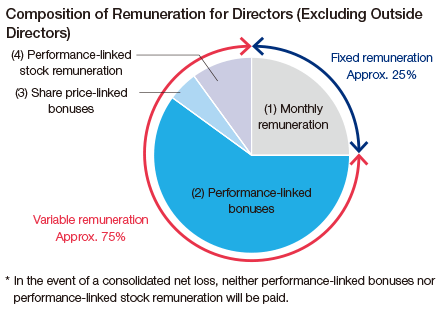
Under the current remuneration plan for Directors, the ratio of performance-linked bonuses is not fixed at a set level. Rather, it is designed so that the ratio of performance-linked bonuses to total remuneration of Directors rises in accordance with expansion of operating performance.
| Type | Number of people | Total amount of remuneration (millions of yen) |
Details (millions of yen) | ||||
|---|---|---|---|---|---|---|---|
| Monthly remuneration | Bonuses | Special bonuses | Stock remuneration | ||||
| Directors | Inside | 5 | 1,731 | 445 | 1,000 | 113 | 173 |
| Outside | 5 | 48 | 48 | - | - | - | |
| Total | 10 | 1,779 | 493 | 1,000 | 113 | 173 | |
| Audit & Supervisory Board Members | Inside | 3 | 72 | 72 | - | - | - |
| Outside | 3 | 43 | 43 | - | - | - | |
| Total | 6 | 115 | 115 | - | - | - | |
Calculation Formulas for (2) Performance-Linked Bonuses and (4) Performance-Linked Stock Remuneration
Total Amount Paid to All Directors
Total amount paid to all Directors = (A + B + C) x Sum of position points for all the eligible Directors ÷ 55
A = (Of consolidated net profit for FYE 2020, the portion up to ¥200.0 billion) x 0.35%
B = (Of consolidated net profit for FYE 2020, the portion exceeding ¥200.0 billion and up to ¥300.0 billion) x 0.525%
C = (Of consolidated net profit for FYE 2020, the portion exceeding ¥300.0 billion) x 0.525% (of which, 0.175% as stock remuneration)
The total amount paid shall be the sum of A, B, and C, which shall be adjusted with due regard to the increase / decrease in the number of eligible Directors, the change in position, and other factors. (Remuneration limits exist on bonuses and stock remuneration.)
Amount Paid to an Individual Director
Amount paid to an individual Director
= Total amount paid to all Directors x Position points ÷ Sum of position points for all the eligible Directors
Amount paid to individual Director is determined by dividing total amount paid to all Directors based on points assigned by position shown below;
| Chairman | President | Executive Vice President | Senior Managing Executive Officers | Managing Executive Officers |
|---|---|---|---|---|
| 10 | 7.5 | 5 | 4 | 3 |
Of the amount paid to an individual director, the portion corresponding to A and B is paid entirely in cash. In regard to the portion corresponding to C, 0.175% is paid as stock remuneration and the balance is paid in cash. Furthermore, the value of 70% of the portion paid in cash will increase or decrease depending on the rate by which the responsible organization meets its projected targets. (The plan achievement rate shall be 100% for the eligible Directors for whom no plan achievement rate is measurable.)
In regard to stock remuneration during the term of office, annual points are awarded (1 point = 1 share), and at the time of retirement stock remuneration is paid from the trust in correspondence with accumulated points. Since we plan to procure all the trust stock from the stock market, no dilution will occur.
Calculation Formula for (3) Share-Price Linked Bonuses
Amount paid to an individual Director in X Fiscal year*1 of the medium-term management plan
= (Simple average of daily stock closing price of ITOCHU in the X fiscal year of the medium-term management plan) – (Simple average of daily stock closing price in the previous year of the first fiscal year of the medium-term management plan) x (1,300,000) x (Sum of position points*2 assigned to each Director from the first fiscal year to the X fiscal year of the medium-term management plan) ÷ (108.8 points x X(years)) x (Relative stock price growth rate*3) – (Total amount of share-price linked bonuses from the first fiscal year to the X-1 fiscal year of the medium-term management plan)*4
- Based on the three years—initial year (first year), second year, and final year (third year)—of the medium-term management plan.
- The position points assigned to each Director are the same as those applied for calculating (2) performance-linked bonuses.
- Relative stock price growth rate = (Simple average of daily closing price in the X fiscal year of the medium-term management plan ÷ Simple average of daily closing price of the previous year of the first fiscal year of the medium-term management plan) ÷ (Simple average of daily TOPIX in the X fiscal year of the medium-term management plan ÷ Simple average of daily TOPIX in the previous year of the first fiscal year of the medium-term management plan)
- With respect to the total amount of share-price linked bonuses from the first fiscal year to the X-1 fiscal year of the medium-term management plan, the amount for the first year of the medium-term management plan is set at zero.
